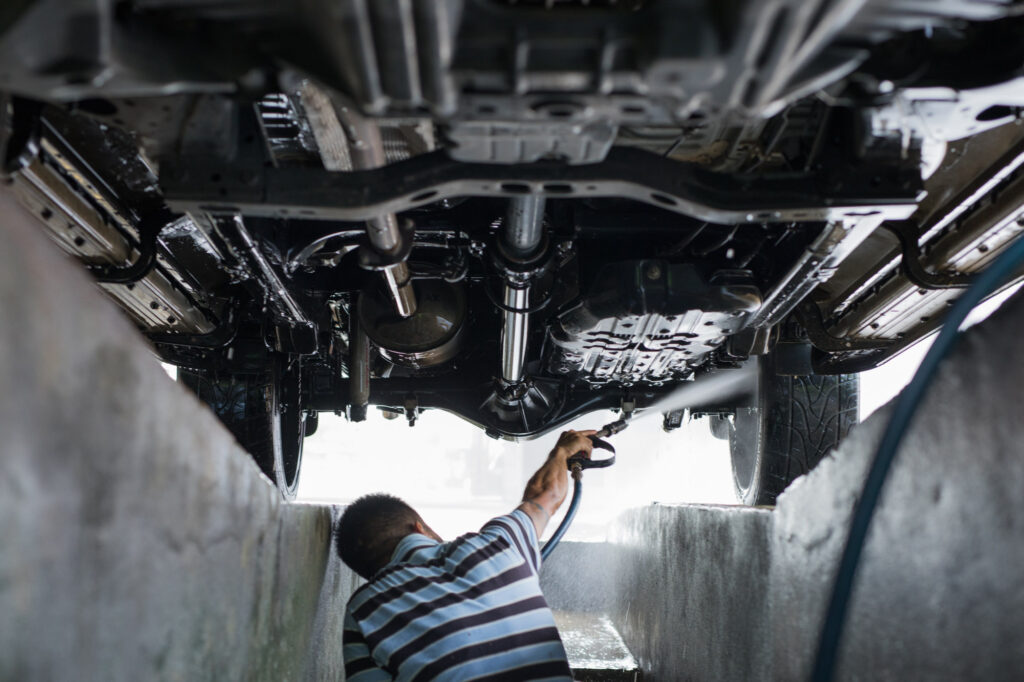Yes, it’s best to keep your vehicle’s undercarriage clean. Though people rarely look at the underside of their vehicle unless they’re looking for something, there’s no denying how important they are. After all, it hosts crucial parts like the transmission system, brake system, and suspension system.
The best way to keep the undercarriage in great shape is to keep it clean.
What Are the Benefits of Undercarriage Washes?
Washing your vehicle’s underside regularly will give you these advantages.

Cleaner Look and Easier Inspections
Dirty undercarriages are unsightly. Keeping yours clean means your ride looks great from all angles. It also makes it easier to inspect your undercarriage for damage or repairs when there’s no dirt or debris in the way.
Reduced Repair Costs
Dirty undercarriages can hide issues and even make them worse. In some cases, the problem could require repairs or part replacements to fix.
Washing your vehicle’s underside regularly makes it easy to spot and address issues. For example, if you’re experiencing brake problems, it’s easier to identify and examine brake parts in the undercarriage for damage when it’s clean.
Rust Prevention
Rust usually builds up in vehicles that seldom get washed. This is because dirt and debris can scratch or shred the protective coating of metal parts, making them more susceptible to corrosion. Cleaning your vehicle’s undercarriage regularly can prevent this problem.
Signs It’s Time for an Undercarriage Car Wash
Because the undercarriage is under the vehicle, it’s hard to tell when it’s time to clean it. Keeping an eye out for these telltale signs would help.
When It’s Dirty
Not only do dirt and gunk look bad, but they can also clog up important vehicle parts, making them slow or less responsive. It also promotes rust buildup, which can cause mechanical damage.
When the Brakes Aren’t As Responsive
Another sign that it’s time to clean the undercarriage is if your brakes don’t work as well as they used to. There are brake lines under your vehicle, and dirt buildup can clog them up and affect braking performance.
When Driving Feels Bumpier
if your vehicle feels bumpier to drive, its undercarriage might be so dirty that it’s causing problems for the suspension system. Washing the undercarriage will help you determine if this is the case or if the suspension issue is due to a different problem.
How to Perform an Undercarriage Car Wash
Knowing when you should clean your undercarriage is important, but so is knowing how to do it properly. You’re going to need the following things before you start:
- Hose or pressure washer
- Soap
- Brush
- Undercarriage wash or cleaning solution

1. Elevate Your Vehicle
The first thing you need to do to clean the underside of your vehicle is to lift it with ramps or jack stands. It’ll give you excellent access to the undercarriage, which is a must because you need a lot of room to inspect and wash it.
It wouldn’t hurt to remove your vehicle’s wheels as well so you can cover more areas when washing the undercarriage. While your vehicle is up, take some time to inspect the various components of the undercarriage, like the brake lines and fuel lines, for signs of damage or corrosion.
2. Hose Down the Undercarriage
Once the vehicle is up, use a hose to soften the dirt and mud stuck in the undercarriage. Alternatively, you can also pressure wash the undercarriage.
When cleaning your vehicle’s underside, it’s best to start from the front before slowly working your way toward the back. Hose the undercarriage components down or use a pressure washer to wash them one by one.
Focus on individual parts as you clean them to be extra thorough.
3. Brush Off Dirt and Debris
Apply soap and water to the brush after rinsing the undercarriage and start scrubbing off stubborn dirt, mud, or gunk.
While the hose or pressure washer has removed or loosed most of the dirt, there might still be some residue left. Fortunately, taking matters into your own hands with a brush should do the trick.
You can also use an undercarriage washer or a cleaning solution to get rid of any unwanted substances. Spray the cleaning solutions onto the various components before wiping them away after a few minutes.
3. Rinse (and Repeat)
Rinse your undercarriage with a hose, then repeat the previous step if you spot any lingering dirt or residue. If it’s clean, wipe it until it’s dry. Don’t let it air dry because the moisture can cause issues for some parts.
Any information provided on this Website is for informational purposes only and is not intended to replace consultation with a professional mechanic. The accuracy and timeliness of the information may change from the time of publication.















